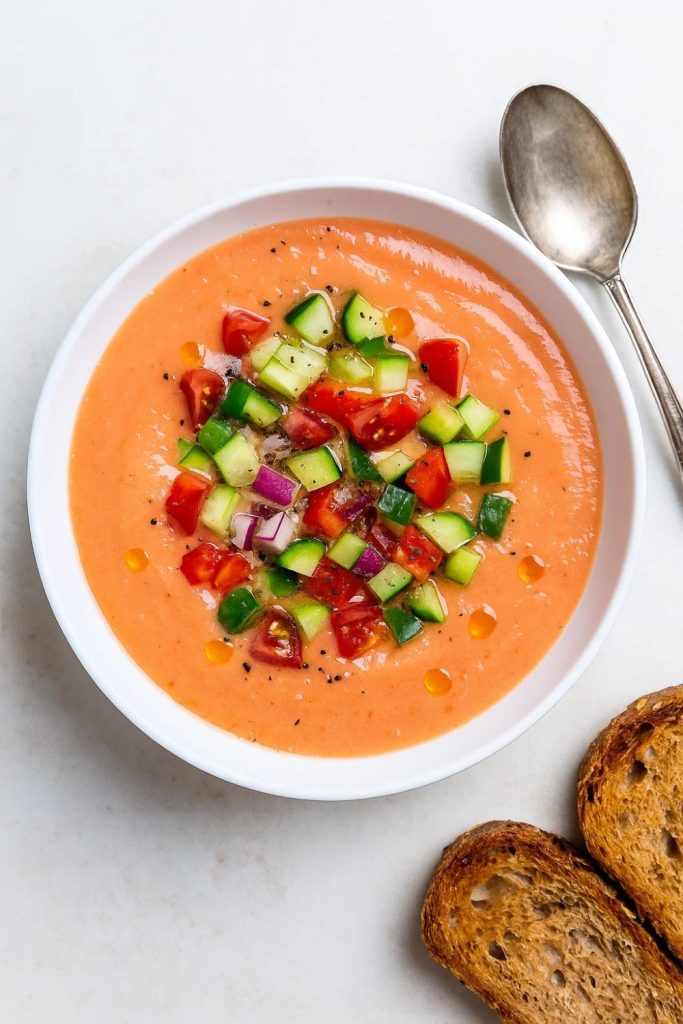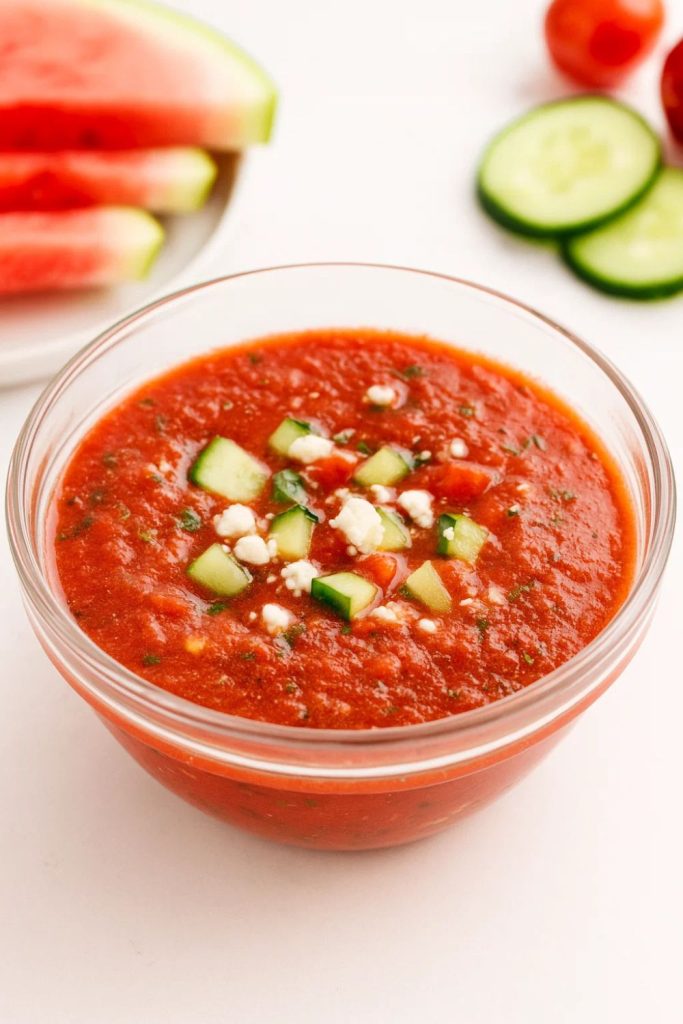Minestrone soup is like a warm hug on a chilly day – hearty, colorful, and bursting with fresh flavors that soothe the soul. This classic Italian soup blends garden-fresh vegetables, tender beans, and aromatic herbs into a nourishing meal that feels both wholesome and comforting.
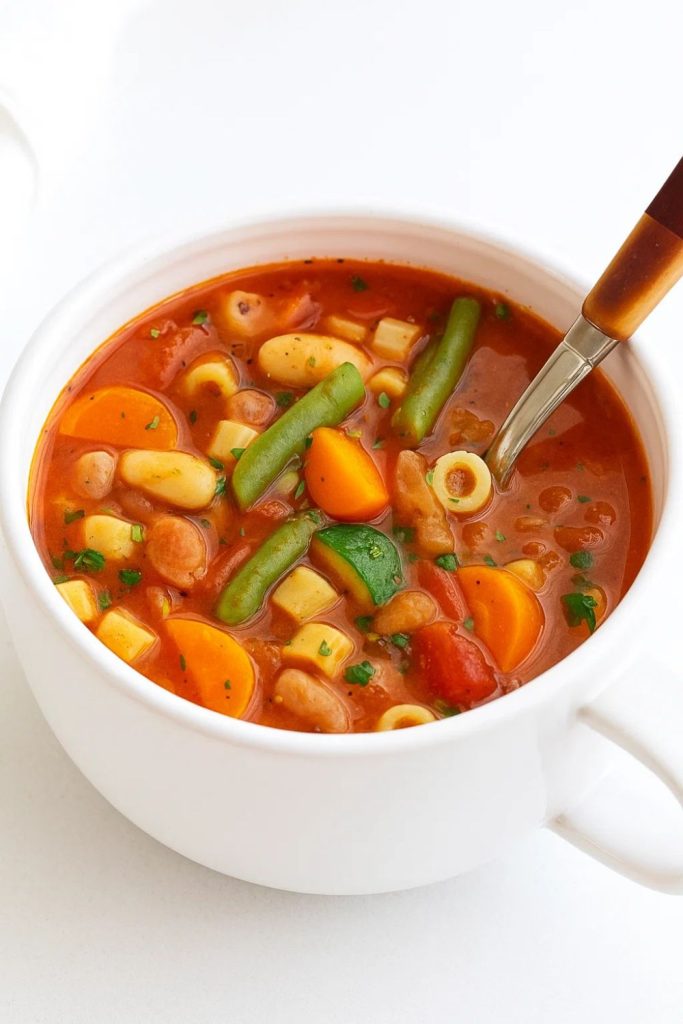
The beauty of minestrone lies in its history and humble origins.
Rooted in Italian peasant cooking, this soup was designed to use whatever vegetables were in season and whatever scraps were on hand, creating a flexible, thrifty, and deeply satisfying dish.
I first encountered minestrone in a small trattoria in Tuscany, where the soup was served steaming hot with a drizzle of olive oil and a sprinkle of fresh Parmesan.
It was a revelation — simple ingredients transformed into something deeply flavorful and comforting.
Over time, I’ve adapted this recipe to include a medley of fresh vegetables, fragrant herbs, and just the right touch of tomato and beans to create a balanced and hearty meal anyone can enjoy year-round.
Why You’ll Love This
- Rich, Layered Flavor in Every Spoonful
Minestrone soup is a symphony of flavors that blend harmoniously — the sweetness of carrots and onions, the earthiness of beans, the brightness of tomatoes, and the warmth of herbs like rosemary and thyme. Each bite is satisfying and packed with complexity without feeling heavy or overwhelming. - Loaded with Nutritional Goodness
This soup is a powerhouse of nutrients. Packed with fiber from beans and vegetables, it helps keep digestion smooth and promotes fullness. The mix of vitamins A, C, and K from colorful veggies supports immune health and skin vitality. Plus, it’s naturally low in fat and calories, making it a guilt-free comfort food. - Flexible and Easy to Customize
One of minestrone’s greatest strengths is its versatility. Whether you’re vegan, vegetarian, or a meat lover, you can tailor this soup to your preferences by adding different beans, swapping veggies, or tossing in some pasta or grains. It’s also easy to make ahead and reheats beautifully, perfect for busy weeknights or meal prep. - Perfect for Any Season or Occasion
While often thought of as a fall or winter soup, minestrone can be enjoyed all year round. Lighten it up with fresh summer veggies or bulk it up with root vegetables in winter. It works as a starter, a main course, or even a hearty lunch packed for work. Its comforting warmth and vibrant flavors make it a timeless favorite.
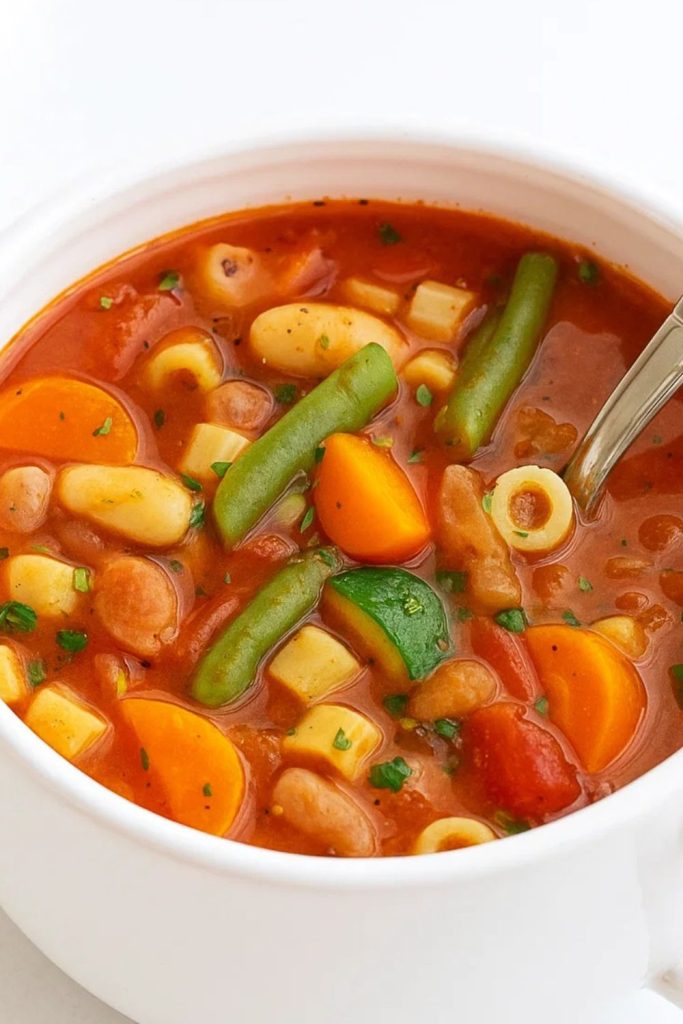
Recipe Details
- Prep Time: 15 minutes
- Cook Time: 40 minutes
- Total Time: 55 minutes
- Cuisine Type: Italian, Mediterranean
- Servings: 6
- Estimated Cost: Moderate (mostly pantry staples and fresh produce)
Equipment Needed
- Large soup pot or Dutch oven
- Wooden spoon or silicone spatula
- Chef’s knife and cutting board
- Measuring cups and spoons
- Can opener (for canned beans and tomatoes)
- Ladle (for serving)
- Optional: Immersion blender (if you want a smoother texture)
Ingredients
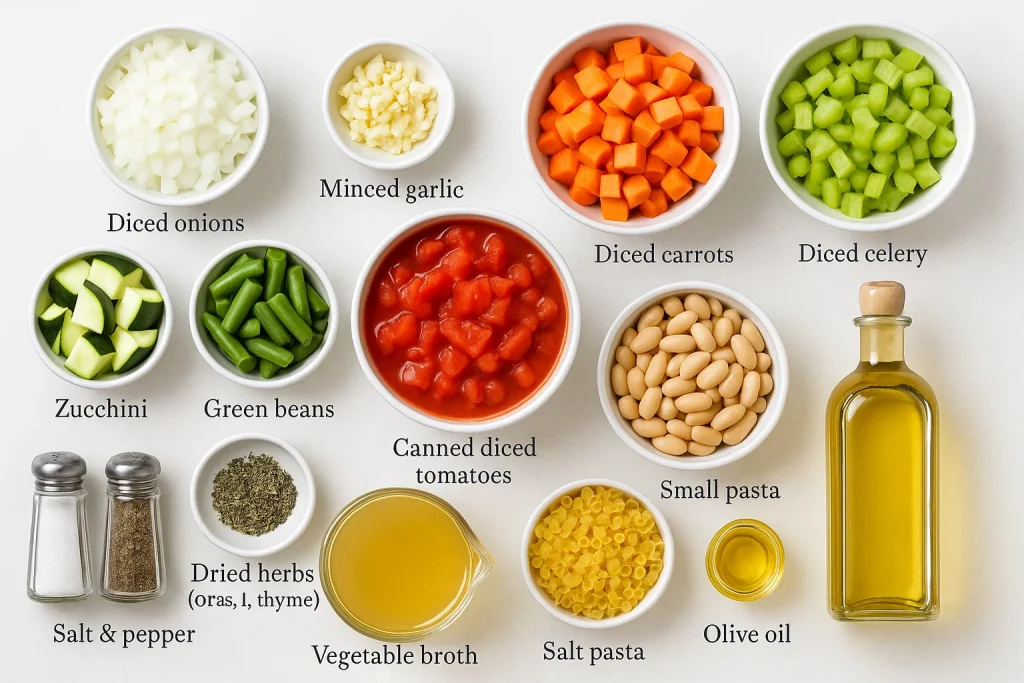
- 2 tablespoons olive oil
- 1 medium onion, diced
- 2 cloves garlic, minced
- 2 medium carrots, peeled and diced
- 2 celery stalks, diced
- 1 medium zucchini, diced
- 1 cup green beans, trimmed and cut into 1-inch pieces
- 1 can (14 oz) diced tomatoes, with juices
- 1 can (15 oz) cannellini or kidney beans, drained and rinsed
- 6 cups vegetable broth (or chicken broth for non-vegetarian)
- 1 teaspoon dried oregano
- 1 teaspoon dried basil
- 1/2 teaspoon dried thyme
- 1 bay leaf
- Salt and freshly ground black pepper, to taste
- 1/2 cup small pasta (like ditalini or elbow macaroni) or cooked rice/quinoa (optional)
- Fresh parsley or basil, chopped, for garnish
- Grated Parmesan cheese, for serving (optional)
Optional substitutes: Use any seasonal vegetables such as spinach, kale, or peas. For a gluten-free option, omit pasta or use gluten-free pasta or grains.
Step-by-Step Instructions
- Sauté the Aromatics
Heat the olive oil in a large soup pot over medium heat. Add the diced onion, minced garlic, carrots, and celery. Cook for about 5-7 minutes, stirring occasionally, until the vegetables are softened and the onion is translucent. This step builds the foundational flavor of your soup. - Add the Vegetables and Herbs
Stir in the zucchini, green beans, dried oregano, basil, thyme, and bay leaf. Cook for another 3 minutes, allowing the herbs to release their fragrance and the vegetables to start softening. - Incorporate Tomatoes and Broth
Pour in the canned diced tomatoes with their juices and the vegetable broth. Stir everything together, scraping the bottom of the pot to lift any browned bits. Bring the soup to a boil, then reduce heat to a simmer. - Simmer to Develop Flavor
Let the soup simmer gently for 20 minutes, uncovered. This slow cooking allows the flavors to meld beautifully. During this time, season with salt and pepper to taste. If you want a thicker soup, simmer a bit longer. - Add Beans and Pasta
Stir in the rinsed cannellini beans and pasta (if using). Continue to simmer for 10 more minutes or until the pasta is tender but still firm. If you prefer grains like rice or quinoa, add them at this point if precooked, or adjust cooking time accordingly. - Final Touches and Serve
Remove the bay leaf. Taste and adjust seasoning as needed. Ladle the soup into bowls and garnish with freshly chopped parsley or basil. Sprinkle with grated Parmesan cheese if desired. Serve warm with crusty bread for a complete meal.
Nutrition Facts (per serving)
- Calories: ~230
- Protein: 10g
- Carbohydrates: 38g
- Fiber: 9g
- Fat: 5g
- Sodium: 600mg (varies by broth used)
- Vitamin A: 70% DV
- Vitamin C: 30% DV
- Iron: 15% DV
- Calcium: 10% DV
Nutrition may vary slightly depending on ingredient brands and substitutions.
Tips for Success
- Use Fresh, Seasonal Vegetables: Fresh veggies give the best flavor and texture, but frozen can work in a pinch. Adjust cooking time accordingly if using frozen to avoid overcooking.
- Don’t Skip the Simmer: Allowing the soup to simmer gently is key for deep flavor development. Rushing this step can result in a bland broth.
- Beans for Protein and Creaminess: Canned beans are convenient, but soaking and cooking dried beans adds extra depth and creaminess if you have time.
- Add Pasta Last: To prevent the pasta from getting mushy, add it toward the end of cooking. Alternatively, cook pasta separately and add when serving to maintain texture.
- Customize Your Broth: Use vegetable broth for a vegan dish, chicken broth for more richness, or even add a splash of white wine for extra depth.
Common Questions
Can I make minestrone soup vegan?
Absolutely! Use vegetable broth and skip the Parmesan cheese or use a vegan alternative. The beans and veggies make it naturally plant-based and satisfying.
What if I don’t have all the vegetables listed?
Minestrone is very forgiving. Use whatever vegetables you have—peas, spinach, kale, potatoes, or bell peppers work great. Just adjust cooking times accordingly.
How long does minestrone soup keep?
Stored in an airtight container, it lasts up to 4 days in the fridge. It also freezes well for up to 3 months—just thaw and reheat gently.
Can I prepare this soup in advance?
Yes! Minestrone often tastes better the next day as flavors meld. Prepare the soup fully, refrigerate overnight, and gently reheat. Add fresh herbs or cheese just before serving for brightness.
Variations & Substitutions
Feel free to put your own spin on minestrone. Add cooked sausage or shredded chicken for a meatier option. Swap the pasta for gluten-free noodles or grains like barley or farro. For a creamier version, stir in a splash of cream or coconut milk at the end. You can also blend part of the soup with an immersion blender for a thicker texture.
Serving & Pairing Suggestions
Minestrone pairs beautifully with crusty Italian bread or garlic breadsticks. A crisp green salad dressed with lemon vinaigrette adds freshness and balance. For wine lovers, a light Italian red like Chianti complements the earthy flavors nicely. For a heartier meal, serve with a side of roasted vegetables or a cheese platter.
Minestrone Soup
Ingredients
- 2 tablespoons olive oil
- 1 medium onion diced
- 2 cloves garlic minced
- 2 medium carrots peeled and diced
- 2 celery stalks diced
- 1 medium zucchini diced
- 1 cup green beans trimmed and cut into 1-inch pieces
- 1 can (14 oz) diced tomatoes, with juices
- 1 can (15 oz) cannellini or kidney beans, drained and rinsed
- 6 cups vegetable broth or chicken broth for non-vegetarian
- 1 teaspoon dried oregano
- 1 teaspoon dried basil
- ½ teaspoon dried thyme
- 1 bay leaf
- Salt and freshly ground black pepper to taste
- ½ cup small pasta like ditalini or elbow macaroni or cooked rice/quinoa (optional)
- Fresh parsley or basil chopped, for garnish
- Grated Parmesan cheese for serving (optional)
Instructions
- Heat the olive oil in a large soup pot over medium heat. Add the diced onion, minced garlic, carrots, and celery. Cook for about 5-7 minutes, stirring occasionally, until the vegetables are softened and the onion is translucent. This step builds the foundational flavor of your soup.
- Stir in the zucchini, green beans, dried oregano, basil, thyme, and bay leaf. Cook for another 3 minutes, allowing the herbs to release their fragrance and the vegetables to start softening.
- Pour in the canned diced tomatoes with their juices and the vegetable broth. Stir everything together, scraping the bottom of the pot to lift any browned bits. Bring the soup to a boil, then reduce heat to a simmer.
- Let the soup simmer gently for 20 minutes, uncovered. This slow cooking allows the flavors to meld beautifully. During this time, season with salt and pepper to taste. If you want a thicker soup, simmer a bit longer.
- Stir in the rinsed cannellini beans and pasta (if using). Continue to simmer for 10 more minutes or until the pasta is tender but still firm. If you prefer grains like rice or quinoa, add them at this point if precooked, or adjust cooking time accordingly.
- Remove the bay leaf. Taste and adjust seasoning as needed. Ladle the soup into bowls and garnish with freshly chopped parsley or basil. Sprinkle with grated Parmesan cheese if desired. Serve warm with crusty bread for a complete meal.
Notes
- Use Fresh, Seasonal Vegetables: Fresh veggies give the best flavor and texture, but frozen can work in a pinch. Adjust cooking time accordingly if using frozen to avoid overcooking.
- Don’t Skip the Simmer: Allowing the soup to simmer gently is key for deep flavor development. Rushing this step can result in a bland broth.
- Beans for Protein and Creaminess: Canned beans are convenient, but soaking and cooking dried beans adds extra depth and creaminess if you have time.
- Add Pasta Last: To prevent the pasta from getting mushy, add it toward the end of cooking. Alternatively, cook pasta separately and add when serving to maintain texture.
- Customize Your Broth: Use vegetable broth for a vegan dish, chicken broth for more richness, or even add a splash of white wine for extra depth.
Minestrone soup is a classic example of how simple ingredients can create a dish that is both comforting and nourishing.
Whether you’re new to cooking or a seasoned home chef, this recipe is easy to follow and endlessly adaptable.
Gather your veggies, simmer slowly, and enjoy a bowl full of warmth and wholesome goodness.
Happy cooking!

